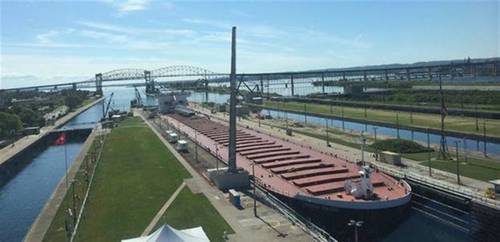NOAA and partners document surge in Great Lakes water levels; levels expected to stay above-average through winter and spring of 2015
Scientists at the Army Corps of Engineers, Environment Canada and NOAA documented a record-setting surge in water levels on Lakes Superior and Michigan-Huron that began in January 2013, and has continued through November 2014. The United States and Canadian federal agencies expect water levels to stay near or above average on all of the Great Lakes over the next six months.
At no other point in recorded history have water levels risen as much on Lake Superior and Michigan-Huron over the same two-year period, NOAA said. Since September 2014, all of the Great Lakes have been above their seasonal averages for the first time since the late 1990s.
“The recent surge in water levels brings to an end a 15-year period of persistent below-average water levels on Lakes Superior and Michigan-Huron,” said Drew Gronewold, a research hydrologist with NOAA’s Great Lakes Environmental Research Laboratory. “However, it is uncertain if, years from now, water levels will continue to rise, or if they will fall again to below-average levels.”
Part of the uncertainty in long-term future water levels projections comes from the challenge of predicting not only the major drivers of the Great Lakes water budget (which are over-lake precipitation, runoff and over-lake evaporation) but also large-scale climate forces, such as last winter's Arctic polar vortex anomaly, which influence those drivers.
The surprisingly swift rebound in water levels broke records across the region. The net rise in water levels on Lake Superior from January 2013 through November 2014 was roughly 2.3 feet (about 0.7 meters), the highest net increase ever recorded for that 23-month period. Similarly, on Lake Michigan-Huron, the net rise in water levels from the record-low in January 2013 through November 2014 was 3.2 feet (about 1 meter), an increase that tied the previous record set in 1950-1951 for the same 23-month period.
The current surge in water levels has largely provided relief to communities, businesses and industries that depend on the Great Lakes, including commercial shipping, hydropower, recreational boating and tourism. However, high water levels can have negative effects as well, including coastal erosion, flooding, and property damage along the shoreline. The severe storm in October 2014 that lashed the shores of southern Lake Michigan is just one example.
Research from NOAA, the Army Corps, Environment Canada and regional academic institutions indicates that increases in seasonal precipitation are the major cause of the recent water level surge. Measurements from a growing network of off-shore evaporation monitoring stations indicate that evaporation rates in the recent two-year period have not been particularly low despite recent cold winter temperatures and record high ice cover. So while high evaporation rates were a major factor in keeping water levels low between 1998 and 2013, an increase in precipitation appears to be the major driver of the recent water level surge.
Data suggests that precipitation in the Lake Superior and Lake Michigan-Huron basins was about 10 percent above long-term averages in both 2013 and 2014, while precipitation in 2012 (a year of drought that preceded the record low water levels on Michigan-Huron) was roughly 10 percent below the long-term average.
NOAA and Army Corps scientists are also studying how a changing climate may contribute to water level changes. To improve the understanding of the relationship between climate change and Great Lakes water levels, GLERL researchers and their academic partners analyze relationships between evaporation from the lakes, seasonal ice cover, and long-term heat storage in the lakes.
• 

 February 2024
February 2024


